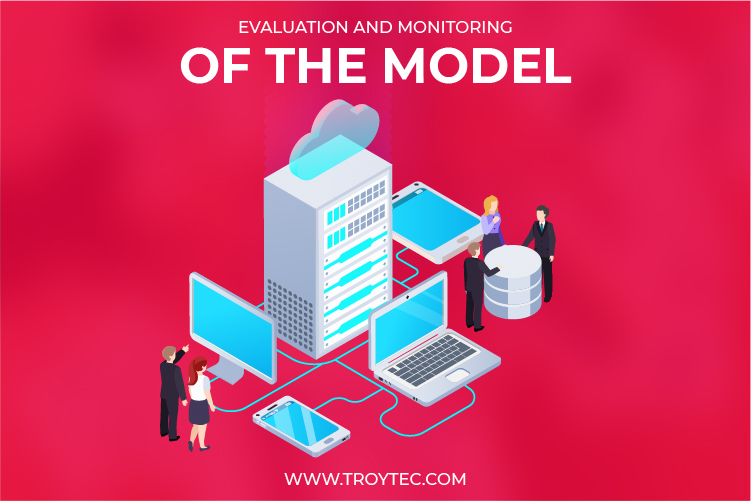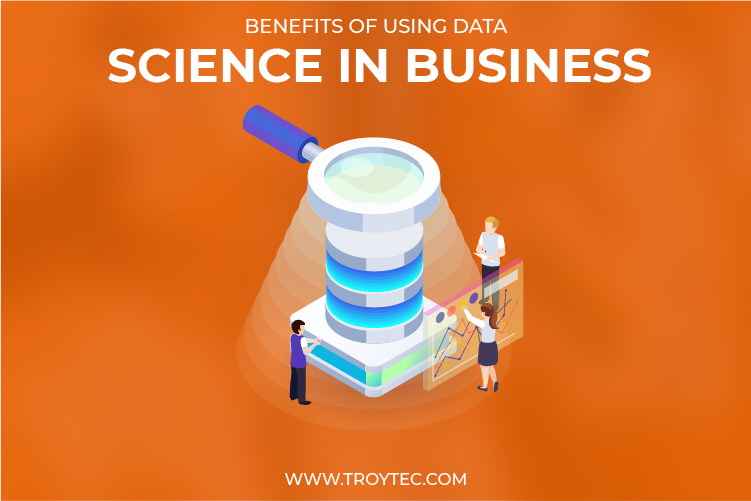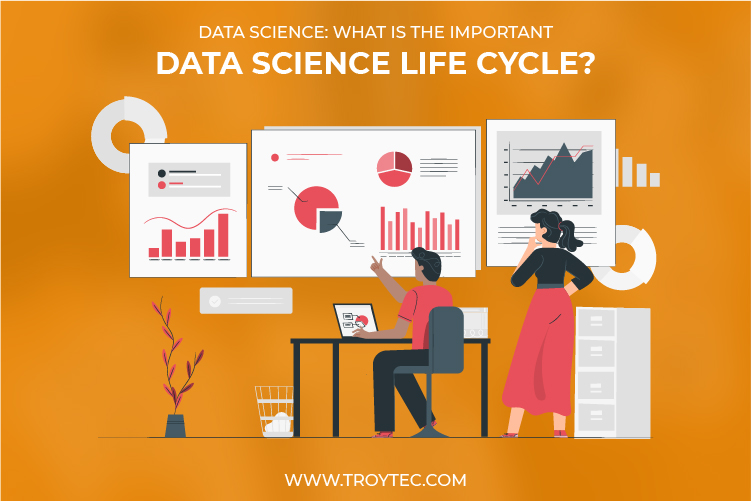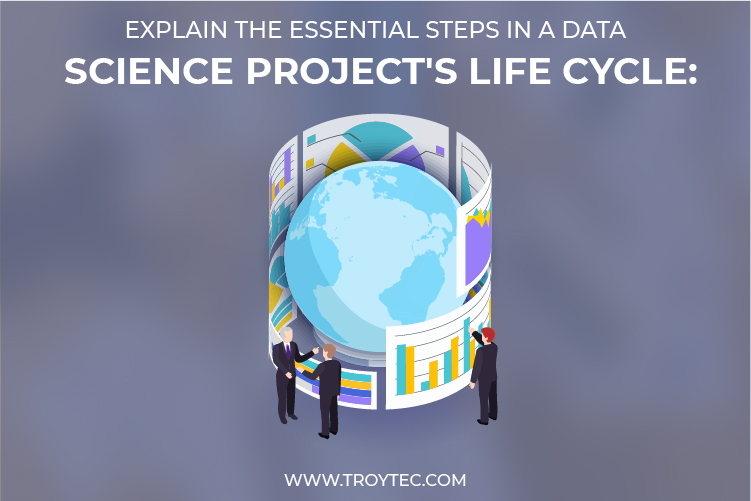Data science: Explain the important Data Science Life Cycle?
Data Science combines two sectors: data and science. So, Data Science is the systematic study of data and the derivation of knowledge through testable methodologies to make predictions about the world.
Put another way; it’s the process of data of any scale and source. Data has evolved into new fuel for today’s enterprises.
That’s why it’s critical to comprehend the data science project life cycle. You must be aware of the essential phases as a Data Scientist, Machine Learning Engineer, or Project Manager.
In most cases, the essential component of a Data Science project is data. We won’t be able to make any analysis or anticipate any consequences if we don’t have any data because we’re dealing with an unexpected situation.
As a result, we must first identify the underlying problem statement provided by our clients or stakeholders before beginning any data science project. We must collect essential data that will assist us in solving the use case once we have grasped the business problem.
The repetitive stages used to design, distribute, and manage any data science product are referred to as a data science lifecycle.
As no data science initiatives are, they have different life cycles. Yet, we may envision an overall lifespan that encompasses some of the most frequent data science procedures.
Machine learning algorithms and statistical approaches are used in a comprehensive data science lifecycle process to improve prediction models. Data extraction, preparation, cleansing, modeling, and evaluation are the most frequent data science steps included in the complete process.
The following are the essential steps in a Data Science project’s life cycle:
Understanding the Client’s Business Challenge
Before designing a successful business model, you must first understand the client’s business problem. Suppose he wishes to predict the client turnover rates in his retail business. It would be beneficial if you first learned about his company, requirements, and expectations from the estimate.
Even a minor inaccuracy in identifying the problem and comprehending the need can significantly impact.
Even the tiniest mistake in identifying the problem and interpreting the need can significantly impact the project, so you must do it with extreme care.
The domain expert knows everything there is to know about the application domain and the problem that needs to be solved. Data Scientists are domain experts who can assist in identifying issues and viable solutions.
Preparing data
This stage aids in comprehending the data and prepares it for subsequent analysis.
All techniques involved include collecting necessary data, integrating it by combining data sets, and cleaning it. They cope with incomplete data by either removing them or applying them with relevant data, dealing with inaccurate data by deleting it, and checking for and dealing with outliers.
You can build new data and extract unique features from current data via feature engineering. Remove any extra columns or functions from the data and format it according to the structure you want.
The most time-consuming phase, accounting for up to 80% of the total project duration, is data preparation, the most critical step throughout the life cycle.
At this point, exploratory data analysis (EDA) is crucial since summarizing clean data allows you to identify the data’s structure, outliers, anomalies, and trends. Such features can help choose the optimal set of qualities, develop a model-creation algorithm, and construct the model.
Modeling Data
After the data has been analyzed and visualized, the next stage is data modeling. The main components of the dataset are retained, and the data is refined further. Now it’s up to you to select how you want to represent the data.
The appropriate activities, like classification or regression, are determined by the required business value. There are numerous modeling options accessible for these tasks.
The Machine Learning engineer analyzes the data and generates the results using various methods. While modeling data, the models are often first tested using dummy data similar to the actual data.
After that, we need to smooth the hyperparameters of the chosen models to get a good result.
Next, we assess the model’s accuracy and relevance. In addition to this project, we must ensure a proper balance of specificity and generalizability, which means that the model generated must be unbiased.
Evaluation and monitoring of the model

There are many different techniques to model data; it’s crucial to determine which one is the most effective. The evaluation and monitoring phase of the model is critical.
The model is now being put to the test with real-world data. When there are few data points, the result is evaluated for improvement. Data may change while the model is being evaluated or tested, and the output will radically change. As a result, there are two phases to consider when evaluating the model:
Analyze Data Drift
Data drift is the term for changes in input data. Data hover is a regular occurrence in data science since data will change based on the situation.
Data Drift Analysis is the study of this change. The model’s precision is determined by how well it handles data drift. Changes in data are primarily due to changes in statistical qualities.
Examining Model Drift
They can use machine learning algorithms to find data drift. Modeling Drift Analysis is critical because, as we all know, change is unavoidable. Incremental learning can be effective when the model is exposed to new data incrementally.
Taking action based on knowledge
To make data science work, you must complete each step listed above with great attention and accuracy. When the procedures are followed correctly, the reports generated in the previous stage assist the company in making crucial decisions.
The information gathered aids in strategic decision-making, such as predicting the need for raw materials ahead of time. Data science can significantly aid many crucial decisions connected to business growth and more excellent revenue production.
Creating business intelligence reports
The model is used to obtain insights that aid in company strategy decisions. These insights are inextricably linked to corporate objectives. Know how the business is doing. Many reports are generated. These reports assist in determining whether or not essential process indicators have been met.
Implementation of the Model
We must see whether we have made the proper solution after a thorough examination before deploying the model. It is then distributed in the channel and format of your choice. It is, of course, the final stage of a data science project’s life cycle.
To avoid unintended errors, please exercise additional caution when performing each stage in the life cycle.
For example, if you use the incorrect machine learning method for data modeling, you will not attain the needed accuracy and will have difficulty obtaining stakeholder support for the project. If your data isn’t adequately cleaned, you’ll have to deal with missing values or noise in the dataset afterward.
As a result, comprehensive testing will be required at each phase to ensure that the model is effectively deployed and approved in the Real World as an optimal use case.
Benefits of Using Data Science in Business

Data science’s goal is to assist businesses in identifying patterns of variation in data, such as customer information, business growth rates, data quantities, or any other variable that they can monitor. Data science is all about working with statistical/probabilistic models to help comprehend change/improvement in existing or historical data.
Data science has been a game-changer for organizations worldwide regarding operational efficiency. Let’s look at the significant advantages of using data science in the workplace:
Improve Business Penetration and Promote New Ideas
Data scientists hold the key to developing better solutions because of their capacity to detect complicated business challenges using machine learning, such as operations research issues. Data scientists are involved in reports on industry developments, internal resource expenditures, profit expectations, workflow bottlenecks, and enhancing the performance of the business model with informed goals.
Conclusion
All of the processes outlined above are equally applicable to novice and experienced data scientists. As a newbie, your task is to learn the technique first, then practice and launch smaller projects.
Data science has become a daily thing of its success in various applications. Data science has benefited everyone, from the petroleum industry to the retail sector.
A thorough understanding of the data science life cycle and the effective execution of the abovementioned processes benefit corporate growth. Many tools are available to extract insights from data, which they can use to improve business.
Fortunately for novices, much of the data has already been cleansed, making the next steps quite simple.
In the real world, however, you must obtain data that meets the needs of your data science project, not just any data set. It helps to minimize misunderstandings if you can convey tasks to your team and clients using a well-defined collection of standardized artifacts.
This process aims to keep a data-science project on track toward a defined engagement endpoint. It’s a process of investigation and discovery, and Even Julia is now one of the most used languages for deploying the model.



Pingback:
Pingback: